Wrangler Keeps Changing, but Stays the Same
Filed under: Weekly test drives, Autos
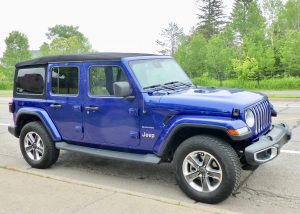
Same familiar look, but the new Jeep Wrangler has considerable refinement beneath the stunning blue paint.
By John Gilbert
It’s been quite a model year for FCA already. FCA, of course, stands for Fiat Chrysler Automobiles, and it encompasses the Italian parent Fiat, along with what used to be Chrysler Corporation — Chrysler, Dodge, Jeep and Ram — blended into Fiat and its impressive holdings, Ferrari, Alfa Romeo, Lancia, and, of course, Fiat.
Thanks to Ram and Jeep, FCA has seemed to have withstood the current woes plaguing the global auto industry, in which cars are in the downward stroke of the vehicle-buying pendulum, headed for what many executives at General Motors and Ford see as oblivion, displaced by the upsurge of trucks — all manner of trucks and SUVs, which have zoomed past cars in popularity and profitability.
Ford has declared it will stop building almost all cars — Taurus, Fusion, Focus, Escort, you name it — to make room for building more trucks. GM says the same thing, planning to eliminate all sorts of historically significant vehicle nameplates in order to convert plants from cars to trucks, trucks and more trucks.
It’s the same with Toyota, which is even now changing over a plant that builds Corolla compacts to accommodated building more RAV4 crossover SUVs — now the top nameplate at Toyota, even outselling Camry and Corolla.
FCA has not ignored the trend, and is eliminating a few cars, although it has fewer cars than Ford or GM. It sounds as though the Charger and Challenger will remain, but parent and dutiful owner Fiat is watching closely and pulling the strings. Ram trucks, and the amazing Jeep line of utility vehicles have carried the corporation’s stabilization.
The Ford F150 pickup remains the top-selling vehicle in the U.S., but has leveled off, and the traditional runner-up, the Chevrolet Silverado, has fallen off even more in their annual duel of full-size trucks. Despite the tiresome late-night and sports-event ad campaign coming at you with alleged “real people, not actors” who rave about how much more they love the Chevy truck — including one that says, “I traded my Ram for a Silverado” — one of the more startling bits of information is the current marketplace results.
With a classy redesign and an amazingly attractive interior, word out of Detroit was that the Ram outsold the Silverado almost 2-to-1 in the month of June, something I found hard to believe, based on habitual U.S. buyers and their knee-jerk habits.
All of which brings us to today’s topic, which is: Jeep.
While the auto industry has struggled for most of this model year, FCA has improved its total foothold, thanks to the Ram and the Jeeps. The Challenger and Charger remain high-performance muscle-car throwbacks, and the Pacifica minivans, improved though they are with their latest hybrid models, have dropped off a bit and FCA is thinking about adding a renewed Caravan or Voyager base minivan that could sell for less than the high-tech Pacifica.
Jeep, meanwhile, stands alone as one of the most interesting and curious brands. It has some very impressive new family models, such as the Grand Cherokee, the Cherokee, the Compass and the compact Renegade, but the backbone of the whole Jeep line is the Wrangler — the basic, off-road specialist that has been refined thoroughly and repeatedly to become more “civilized” but without losing any of its quite-amazing off-road capability. And you can’t get more civilized than the flashy blue paint on my test Wrangler.
The Wrangler proved it is refined to the point where, amid dozens of compact SUVs taking over the marketplace, Motor Trend tested 20 or more and named the new Wrangler as its “SUV of the Year” for 2019. Incidentally, Motor Trend recently decided to add a third candidate evaluation with SUVs added to the traditional car and truck of the year listings, and the Ram was named Truck of the Year, giving FCA two of the exalted three awards.
I wouldn’t have named the Wrangler SUV of the year in the face of some overwhelming and impressive competition, although when competition gets so tough, it’s understandable why Motor Trend every once in a while clears the air by naming something like the off-roading specialty Wrangler. I am completely impressed with the Wrangler, and those who spend any recreational time off-roading will celebrate the award.
Recently, I had the chance to revisit the 2019 Wrangler, and a mid-summer test week verified my earlier findings that the 2019 Wrangler has made that giant step up to become a worthy family vehicle, with the elimination of the pogo-stick bounciness that I thought was standard equipment on Wranglers.
You could safely say that the Wrangler has made a positive change in -road onrefinement without giving up any of its traditional and historic capabilities off-road. Besides, it’s absolutely cool.
My test vehicle’s biggest obstacle was its name. It was the Jeep Wrangler Unlimited, and indication that it is equipped for heavy-duty use. It was the Unlimited’s elite Sahara model, which means fancier features that shouldn’t prevent it from bounding over the Sahara Desert’s sand dunes like the old television series “Rat Patrol,” which made World War II Jeeps its central figures. And it was “Trail Rated,” which means it is built to go anywhere, whether there are roads or not.
That’s it: The 2019 Jeep Wrangler Unlimited Sahara 4X4, Trail Rated.” But when you want to bring all those subtitles into the spotlight, so the guy parked next to you at the ballgame won’t think you have just an ordinary Jeep, you get silver badges that say “Jeep” in familiar bold type, and above that a smaller “Sahara,” and above that a round emblem that denotes the “Trail Rated” capability.
Fortunately, there was no available room to add to the price tag, either: $52,210. That’s up from the base price of $38,395, and reflects the addition of all sorts of modern conveniences, such as the back-up camera, the third generation Dana rear axle over the heavy-duty suspension with its gas-charged shocks, skid plates and shields protecting the fuel tank, the transmission and the transfer case, a trailer-sway damping feature, electronic stability control and roll mitigation, security device, and, it says here, universal garage door opener.
Those are standard on this model, and there are options added on, including: leather trimmed seats with “Sahara” embossed, cold weather package with heated seats and steering wheel, remote start, LED reflector headlights, foglights, taillights and daytime running lights, a premium audio system, rear park-assist, blind-spot detection, hill-descent control, and full frontal collision avoidance. Oh yeah, and there’s satellite radio, push-button start, and a GPS that plays out on a center stack screen.
You think those Rat Patrol ruffians might have enjoyed those features?
It was blue, but hardly a garden-variety blue. Named “Ocean Blue Metallic Clearcoat,” that moniker falls short of defining the stunningly deep blue that penetrates your senses like a laser-beam.
Among the selections you are required to make is with the engine. There is, you should know, still another upgrade, to the “Rubicon” model, which includes the 3.6-liter V6 engine, although I am convinced the way to buy the Wrangler is with the new 2.0-liter 4-cylinder I had in the tester.
Consider these facts: The 3.6 V6 has 285 horsepower to the 2.0’s 270; but the V6’s healthy 260 foot-pounds of torque can’t beat the 2.0’s 295 foot-pounds. The V6 has a 6-speed automatic, the 2.0 gets the new 8-speed.
The lighter 4-cylinder also aids the Wrangler’s agility, with improved balance, although both, of course, have part-time 4-wheel drive that can be locked into your choice of settings. When on the road, you probably would choose the rear-wheel-drive only setting to aid fuel economy, and be impressed with something approaching sporty car handling.
Those who have driven or ridden in Wranglers from a decade or two ago might still recall how potent it is in clamoring over rocks and hilly terrain, seemingly without regard to how steep the challenge might be. If your experience with Jeeps is more contemporary, as in the luxurious Grand Cherokee, then you might look on the Wrangler with scorn, assuming it to be primitive.
Never, however, assume. The new Wrangler Whatsitsname will still do everything the old off-road-beating, rugged rock climber will do, but now it cleans up to transport you and your family to the country club. It even has a partial soft-top to turn it into a virtual convertible. We won’t get into removing the doors and leaving the rollbar -quality support structure exposed as you bound off-road.
I still don’t know that I would name it SUV of the Year, but I’m pretty sure that if and when you choose an alternative vehicle for that honor, the Wrangler will beat it off the road, and maybe on the road, too.
Golf SE Can Avoid All the Potholes — Almost
Filed under: Weekly test drives, Features, Autos
By John Gilbert
The annual complaints from Northern Tier U.S auto drivers drivers about the horrible condition of streets and highways has reached a pinnacle this year. We can blame Climate Change, or Global Warming, but a particularly long and tough winter of alternating freezing and mild temperatures has caused countless chunks of pavement to break, buckle and otherwise abandon their intended resting places, leaving nasty traps waiting to ambush unsuspecting tires, wheels and suspensiuon parts.
My city, Duluth, Minnesota, is, I submit, deserving of a nomination for the worst, and who can deny or judge it? I enjoy driving and reporting on an assortment of new vehicles every week to report on them, and I seek out varied real-world roadways to check on the steering and suspension of all these vehicles. But I certainly did not want a close-up and personal validation of my opinions of road conditions.
Out of familiarity with the roads that I travel most frequently, and so it was as I drove a 2019 Volkswagen Golf SE 1.4-turbo for a week recently. I had driven various VW Golf models, including the GTI, Golf R, and reported on a Golf SE with a stick shift during a minus-35-actual stretch of Minnesota winter. And while not trying to overdo it with repetitious reviews, this is supposedly the final year that we will get the tried-and-true Golf models in U.S. showrooms, which I have declared a sad thing; we’ll enjoy getting the GTI and Golf R, but the base car — the SE — is special on its own. It comes with VW’s newest engine, a 1.4-liter four-cylinder from a whole new engine family, bolstered by a turbocharger to extract surprising power from such a small engine.
The test car has a base price of $25,245, and a sticker of $27,435 as equipped. With only 147 horsepower, its 1.4 lacks the power of the corporate 1.8 or 2.0, but it has abundant torque, which peaks at 184 foot-pounds at a mere 1,400 RPMs — more than the bigger engines. This test car, in a medium Silk Blue Metallic paint job with alloy wheels, had an 8-speed automatic with almost-hidden paddle shifters on the steering wheel. So you get beyond the lack of horsepower by downshifting, then running the revs up to the pleasant feeling as the torque comes through.
Golfs always ride well, with supple but moderately firm suspension, which allows even the base car to take turns in a sporty manner. With all the contemporary safety elements built in — electronic stability control, anti-slip regulation, anti-lock brakes with electronic brake assist — the 4-door hatchback Golf is a safe, solid luxury compact that can get more than 38 miles per gallon.
I was able to attain 38.2 mpg in combined city-highway driving, while EPA estimates show 37 highway, and I was over 36 in all-city operation. That’s up there in TDI country, where only the previous turbo-diesel could go.
The 225-45 17-inch Pirelli P7 tires obviously contribute to the excellent handling and smooth ride. So there I was, negotiating the pits and pitfalls of Duluth’s nastiest streets and roads through five days of the week.
The rural highway we live on is a few miles out the North Shore, and as you drive south to join the freeway for the ride into Duluth, you leave the township, with its St. Louis County-maintenance, and enter Duluth’s city limits, where city crews take care of the surface. You don’t need the sign that says “Duluth,” because you can see the white surface, probably concrete, end where it meets the gray asphalt of the city segment.
Without question, the concrete stays amazingly smooth, and the asphalt chunks out in a harsh and irrgular manner. As I drive down on the 55-mph county segment, and slow for the 30 mph residential city rules, I have a practiced routine. The familiar start to the asphalt has re has a couple of modest potholes seem to join hands just to the right of the middle of the road. Being able to see a couple blocks ahead, I generally swing into the oncoming lane until I get past that stretch, then swing back into the right lane.
This time, with my wife, Joan, and older son, Jack, riding with me to meet up with our younger son, Jeff, at the Trampled By Turtles concert at Bayfront Festival Park, I saw a car or two coming toward us. I had to abandon my normal plan, so I chose to straddle the rough patch or go wide right. I chose to go wide right.
Ka-Chonk! My right front absorbed a rugged hit. Turns out, when I swung wide right to miss the moderate but annoying potholes I was aware of, my right front struck a fourth pothole 10 yards ahead that I was not aware of. It was a long and deep pit. As the blow reverberated, I continued driving, feeling nothing out of sorts, and it was with great relief that no serious damage could be detected.
I pulled onto the freeway and got up to the 65 mph speed limit without any hesitation or vibration, but after about a mile, a little warning sign came on the instrument panel: “Air loss detected in right front tire.” I slowed down immediately, cursing the bad luck, but I couldn’t pull off immediately because of a narrow shoulder. By the time I could, I felt the pull of the deflated tire. Sure enough, the impact of the tire striking what amounted to the far cliff of the Grand Canyon not only blasted a hole in the tire’s sidewall, it scratched up the flashy alloy wheel a bit, too,
It was impressive that the Pirelli P7 took the blow and held its integrity for a mile or so, and it was more impressive that the tire-sensor relayed such quick and accurate information.
With Jack as lead pit-crew guy, we changed it for the space-saver spare, and I drove gingerly the rest of the night and on to Sunday. The timing of my test-drive, though, was to end when the Chicago fleet delivery guys would pick up the Golf SE at 11 a.m. Monday and drive back to Chicago.
We didn’t want them driving that far on the space-saver, so I called Volkswagen of Duluth early Monday morning, explained what had happened, and inquired about their supply of P7s. They had four in stock, they said. When I got there, however, we realized that they were from a year-old supply and the new one was an inch larger, at 17. We talked it over, and I asked if they might have exactly the same SE model on their lot, and they did. Service manager Calvin Edel summoned the unsold car and his service crew did a quick remounting job.
Just to make sure there would be no imbalance, they put the new tire on the right rear and rotated the right rear to right front. Good move. I made it home about an hour before the drivers showed up, and they appreciated the quick and efficient work of Volkswagen of Duluth.
That VW dealership, by the way, is primarily responsible for recalibrating and legalizing almost all the many recalled Golf, Jetta and Passat TDI models to bring their turbo-diesel engines into full compliance, before being sent to dealers throughout the Upper Midwest, where they represented one of the great car values of our time. That’s impressive, especially if they do as thorough a job as they did changing and remounting that tire for the Golf SE.
The caution with which we take on the Pothole Obstacle Course driving through Duluth has been amplified. We’ve got some potholes this year that, to be fair, should register on the nav screen’s GPS.
Spacious Palisade Gives Hyundai Luxury SUV
Filed under: Equinox, Autos
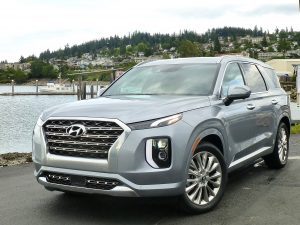
The 2020 Hyundai Palisade made easy work of a trip through the mountains from Coeur d’Alene, Idaho, to Bellingham, Wash.
By John Gilbert
COEUR d’ALENE, Idaho
Hyundai’s SUVs are selling at a fantastic rate, but the company also has heard from consumers with three or more kids: “We want more room.” Even the most loyal Hyundai buyers have to turn to Toyota, Ford or General Motors if they want a larger, three-row SUV, because Hyundai’s fleet consists of midsize and smaller.
Hyundai has swiftly addressed those concerns with its largest SUV, called the Palisade.
A few years ago, I couldn’t have guessed what a Palisade actually is, but living on Minnesota’s North Shore of Lake Superior, you get used to the large, substantial, rock cliffs that rise straight up from the scenic shoreline in a spectacular ridge that runs from Duluth to beyond the Canada border. One of the neatest North Shore tourist sites is the comparatively unknown turnoff to “Palisade Head.” The view from atop Palisade Head is fantastic, and some adventurers bring rock-climbing gear and conduct rappelling exercises over the edge and 200 feet straight down.
“Our vehicle names generally are taken from Southwest or Western locations,” said Mike O’Brien, Hyundai’s vice president of product planning. “This time, we wanted to match the character of a fortress, something substantial. Palisade represents a slice of a cliff, and symbolizes strength.”
O’Brien has never been to Palisade Head, but he was addressing automotive media types summoned in several waves to Coeur d’Alene, a jewel of a mountain resort spot located right in the narrow northern part of Idaho, for the first driving impressions of the 2020 Palisade.
The Palisade replaces the Santa Fe XL as the largest SUV from the South Korean company, and while its bold grille doesn’t resemble anything seen on the Santa Fe, Tucson or Kona, it breaks new styling ground while accumulating all of the almost futuristic features of those smaller siblings, while aiming higher. Hyundai’s history of building safe, strong vehicles that over-achieve is commendable, but now there is a vehicle for those wanting more luxury, and room.
The Palisade could alter Hyundai’s image because of its remarkable luxury fittings. “We’ve focused on premium design and materials,” said O’Brien. “It’s a new image for us.”
However, Hyundai won’t exactly be departing from its reputation of providing high-value, bargain vehicles because of its surprisingly modest price. SUVs with the size and features of the Palisade are often up to twice Palisade’s price, which starts at $31,580 for the base SE. At $33,500, the SEL upgrades to accept all sorts of feature packages that can add another $10,000. The top Palisade Limited model starts at $44,700, and it, too, can add price with some amazing option packages. The Limited I road-tested hit a total of $47,605, but at that its equipment made it pretty special. AWD is standard on the Limited but can be ordered on any model.
“We have strong loyalty to our sedans, like the Sonata, Elantra and Accent, but subcompact SUVs have become the largest segment with midsize SUVs a close second,” said O’Brien. “Sixty-five percent of our total sales come from SUVs.”
With 10 new or substantially redesigned models introduced in the last year, Hyundai has had 10 consecutive months of increased sales over the previous year, and CEO Brian Smith said that while the industry is down 5 percent, Hyundai is up 5 percent.
Our press test-drive included stunning scenery, going more than 100 miles south, to Moscow, Idaho, where we had lunch at the Lodgepole Restaurant — the fish and chips featured Alaskan halibut! — and back, along some scenic, twisty mountain roadways. It was a well-devised route, but I was able to set up a way to get an extended test, after our wave ended at the fabulous Coeur d’Alene Resort.
A Palisade Limited AWD joined me for a memorable daylong drive from Coeur d’Alene westward, past Spokane and then away from the freeway up Hwy. 2 to the Grand Coulee Dam, then to the Chief Joseph Dam, and northward to Winthrop, a neat tourist-intense little Central Washington town, and finally onward, to Bellingham, Wash., and the Pacific Ocean, where I spent a few days visiting our younger son, Jeff. In all, that trip covered 495.5 miles — all on the same tankful of regular gas. I calculated over-EPA 28.1 miles per gallon despite the terrain up, down and through the Cascade Mountains.
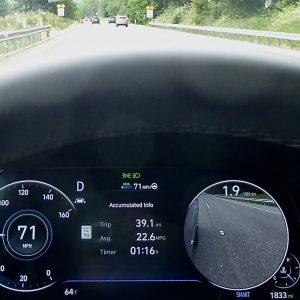
Signal to change lanes, and the speedometer or tach switches to a rear-view camera view of the lane you’re headed for.
Some of the features are refined versions of those Hyundai does very well on such SUVs as the Santa Fe, Tucson and Kona, such as the lane departure warning, lane-keep assist, and lane-centering, plus the excellent radar adaptable cruise control. A new trick is the Palisade’s ultra-helpful instrument panel. If you’re in the middle lane of a 3-lane freeway, and you flick the turn signal to get three blinks to signal a lane change, for example, the large tachometer on the right changes instantly, to a large, round image from a rear/side camera that immediately shows you that the lane is clear. Or not.
Fantastic for entering freeways, too. Otherwise, you can stick with the three-panel navigation screen, which can be adjusted from a panoramic map to a smaller map, with driver information in the adjacent segments.
Another unique feature is the intercom, which lets the driver speak uninterrupted to kids in the back two rows who may have become mesmerized by their audio options. The need for space on the console led to drive-by-wire shift switches instead of the usual shift lever, to save considerable room on the center console. The mode switch allows you to switch from Smart, to Sport, to Comfort, to Eco, or to Snow, and to AWD lock, fitting whatever your driving requires.
Less apparent is the built-in anti-skid control that uses over 50 inputs to predict the conditions for slippage before you actually slip, making it a predictive instead of reactive system. Along with the auto-leveling rear suspension, driving involvement has steering-wheel paddles to control the 8-speed automatic with manual control.
Chief designer Chris Chapman drew a sketch of how the Palisade came to life, to what he calls “personalization” of incorporating a concept into the actual design. As his drawing developed, the key features of the Palisade showed through: balanced on all four wheels, the “C” pillars sloped rearward to the top of the rear wheel-well; the side contours veering away from each other and then meeting again in harmony; the headlights, foglights, driving lights and tail-lights all with an artful design and piercing LED potency; the “shoulders” of the upper sides of the occupant compartment have a minimizing slope to lower the side-window “biceps” just a bit — to put the muscle closer to the wheels, Chapman explained.
“Early on and throughout, that piercing quality became something like an emerging predator, coming up out of the water,” said Chapman.
When a designer gets on a roll, you learn to not interrupt him with needless questions. You simply look for and appreciate the subtle touches, like the three scallops in the rear fascia of the skid plate, with the dual exhaust pipes nestled asymmetrically into the right one.
“It’s a different design,” Chapman acknowledged. “But we’re not doing Russian dolls here, where each one fits inside the other and they all look the same. We wanted to differentiate from the Kona and Santa Fe, and we stressed ergonomics, fit and finish.”
With that, he clicked the projector to replace the Russian dolls pictured with an image of chess pieces, each a different shape and form. The king, of course, is the Palisade.
For structural strength, O’Brien pointed out that the Santa Fe XL graded out to 27.8 in torsional rigidity, and while the all-new Ford Explorer — one of Palisade’s top targets — came in at 27.1, the new Palisade is up to 34.4. To be fair, the 2020 Explorer has 25 percent high-grade steel, but it is aluminum intensive. Hyundai always has featured substantial amounts of high-grade steel, and the Palisade is made up of 59 percent high-strength steel, from Hyundai’s own steel plant. The engineers have found a way to hot-stamp the high-strength steel to improve its rigidity even more.
The Palisade platform is solid enough to feel stiff but not harsh in driving, and rising from that floor is a hoop structure surrounding the passenger compartment, which has been strengthened too. Focus on strengthening the structure included even models with sunroofs, which normally weaken the rigidity. The body was designed to incorporate sound-deadening foam panels under the floor and foam injections into the roof pillars, successful in nearly eliminating wind and road noise.
The low stance and firm structure are coupled with MacPherson strut front and multi-link rear suspensions to handle road fluctuations for the stiff body.
The interior of the Palisade seems closer to full-size than mid-size, but performance of a big SUV is as important as interior space. Hyundai engineering takes care of that, too, with the corporate 3.8-liter V6 delivering 291 horsepower at a peak of 6,800 RPMs, and 262 foot-pounds of torque at 5,200. The price sheet shows it achieves 19 city and 24 highway in EPA fuel economy estimates, but I was able to get it up to 28.1 mpg on my personal trip, up and down mountainsides.
O’Brien explained that the familiar engine has been refined and now combines Atkinson Cycle and Otto Cycle operation, which are opposites in how they adjust valve opening and closing schemes, and they work seamlessly together. “That allows us to get both economy and power,” he said.
The 4,400-pound Palisade AWD also can tow 5,000 pounds in all forms, competing well with the Highlander, Pilot, CX-9, and Explorer. The Explorer is a rear-drive platform, the Palisade front, so when you switch the drive mode to “eco,” you have the efficiency and traction of a front-wheel-drive vehicle. As usual, Hyundai likes to carry its “fight above its weight class” theme, which, because of its interior space, could challenge Yukon, Tahoe, Cadillac SRX and even the Volvo XC-60 and XC-90.
To me, the Palisade drives more like a smaller SUV than one that has so much interior room, and more agility is always a good thing. A unique push-button system makes the second row slide, recline, or flip its backrest forward for ease of entry to the third row, and that third row will surprise adults with how comfortably appointed and roomy it is. It comes with a second-row bench seat, or two captain’s chairs to seat eight or seven. Palisade offers 18 square feet of storage space behind the third row, and it expands greatly when you lower the third, and maybe second, rows.
Many manufacturers are going to assorted artificial leather seat surfaces, and a lot of them are very nice. But the Palisade goes with real Nappa leather, complementing the attention to detail on the doors, dashboard, and even the speaker faceplates is.
With everything folded down, I’m guessing 6-footers could unroll a pad and sleep back there on a long trip. I prefer a resort, but turning the Palisade into a compact mini-motorhome only enhances the pleasure of a trip that could go through the rugged mountains of Idaho and Washington. Or even the North Shore of Minnesota.


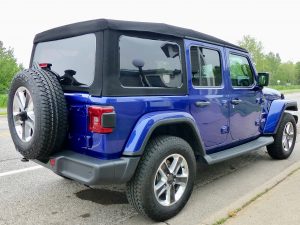
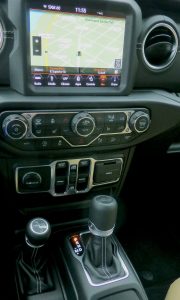
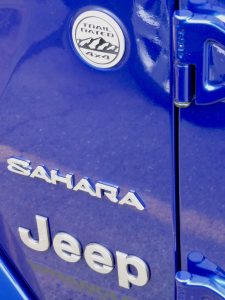
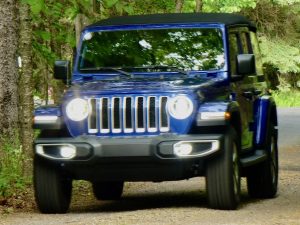
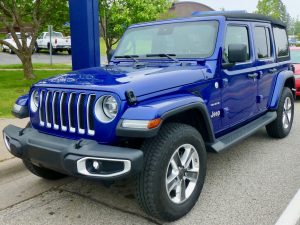
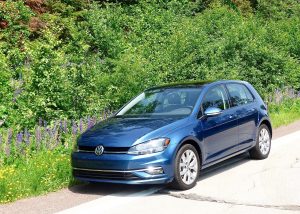
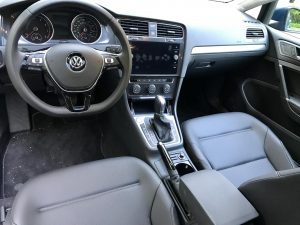
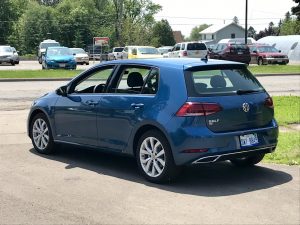
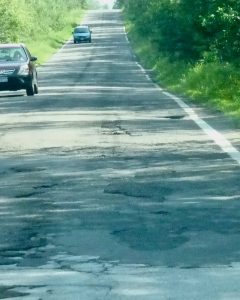
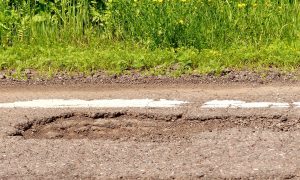
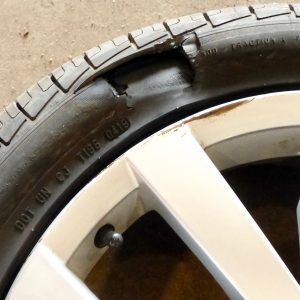
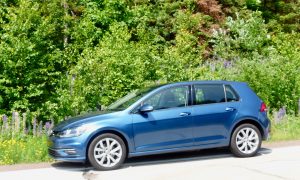
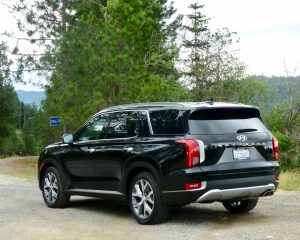
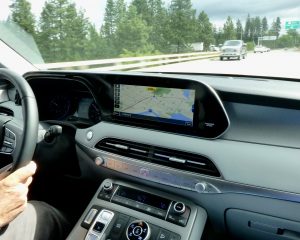
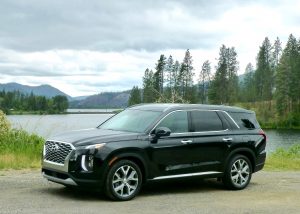
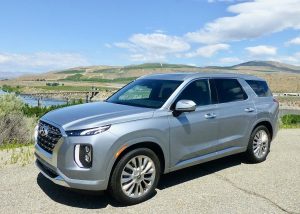
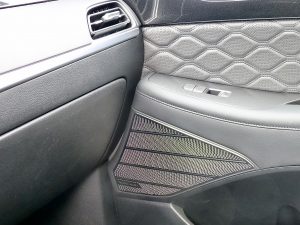
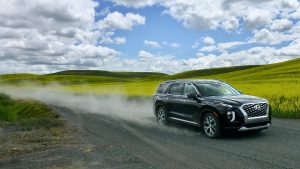
 John Gilbert is a lifetime Minnesotan and career journalist, specializing in cars and sports during and since spending 30 years at the Minneapolis Tribune, now the Star Tribune. More recently, he has continued translating the high-tech world of autos and sharing his passionate insights as a freelance writer/photographer/broadcaster. A member of the prestigious North American Car and Truck of the Year jury since 1993. John can be heard Monday-Friday from 9-11am on 610 KDAL(www.kdal610.com) on the "John Gilbert Show," and writes a column in the Duluth Reader.
John Gilbert is a lifetime Minnesotan and career journalist, specializing in cars and sports during and since spending 30 years at the Minneapolis Tribune, now the Star Tribune. More recently, he has continued translating the high-tech world of autos and sharing his passionate insights as a freelance writer/photographer/broadcaster. A member of the prestigious North American Car and Truck of the Year jury since 1993. John can be heard Monday-Friday from 9-11am on 610 KDAL(www.kdal610.com) on the "John Gilbert Show," and writes a column in the Duluth Reader.